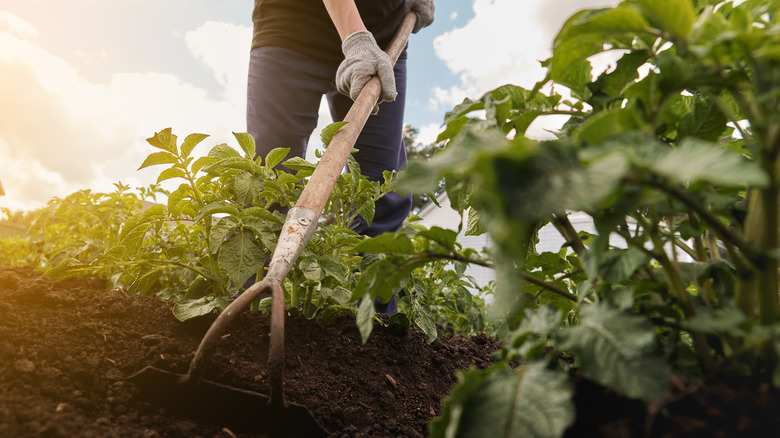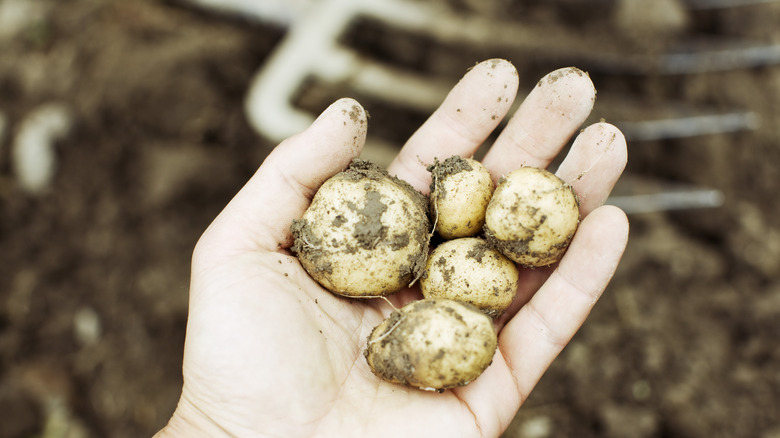How And When To Fertilize Growing Potatoes (& One Big Mistake To Avoid)
Growing your own potatoes in the garden means an abundance of healthy, home-harvested meals. But of all the vegetables you can grow at home, potatoes are among the most demanding. That's because their heavy, meaty tubers need plenty of balanced plant food to develop well and remain disease-free. So before you plant your potatoes, you need to learn how and when to fertilize these nutrient-hungry vegetables properly. Normally, potatoes are fertilized roughly one month after planting by adding the right nutrients to the substrate along the row and hilling the soil up.
Now, if that sounds simple enough, we don't blame you. But the process has a challenging aspect, and that's choosing the right fertilizer. You can't simply buy any plant food off the shelf and hope it will work; in fact, this common mistake can limit your potato harvest. Potatoes are very particular about the nutritional balance in their growing medium, and you may need to run appropriate tests to calculate the right nutrient proportions. Below, we'll walk you through the potato fertilization process from start to finish and give you some tips on how to avoid this big fertilizer mistake.
Finding the most suitable fertilizer and techniques for application
Before you fertilize potatoes, it's best to test the soil to find out its current nutrient composition. Potatoes uptake a wide assortment of nutrients during the growing season but consume potassium and nitrogen in particularly large quantities. Upon emergence, potatoes need these elements in roughly equal measure. However, after a month of growth, their potassium intake skyrockets and surpasses that of nitrogen. So, if the soil test indicates that either of these nutrients is lacking in the growing medium, choose a fertilizer that can rectify this deficiency. Meanwhile, if you find that the soil does not have enough organic matter or micronutrients, you can correct the imbalance by adding organic compost or manure to the soil. Make sure the fertilizer you buy is not of the "feed and weed" variety, as it can kill the potato crops.
You should fertilize the potatoes roughly a month after planting them — this date aligns with the time they're hungriest for nutrients. Apply the plant food along the length of the rows (side-dress), and then hill the soil around the plants. To give the soil a nitrogen boost, apply enough fertilizer to imbue the growing medium with at least 0.15 pounds of actual nitrogen for every 50 linear feet of potatoes growing in a row. You can repeat the same procedure with the same fertilizer type two weeks later, as the potatoes are still at the peak of their nutrient consumption.
Don't over-fertilize your potatoes with nitrogen
Potatoes may be heavy feeders, but fertilizing them with excessive amounts of nitrogen is detrimental to the crops. When too much nitrogen is added to the soil, you'll notice that the potato stalks and foliage are growing vigorously. But these looks are deceiving, since this explosive vegetation growth comes with the cost of poor tuber development.
Needlessly high levels of nitrogen in the growing medium delay the start of tuber development, which means your crops will be smaller at harvest than you expect. What's more, disproportional nitrogen quantities cause the tubers to have a hollow or brown core, or end up looking knotty or disfigured. Even the vibrant foliage that stems from this type of nutrient excess is more susceptible to vine rot. Finally, there's an environmental impact to feeding your spuds too much N fertilizer, since any nitrogen the potatoes don't consume may end up leaking into the groundwater, and eventually, the nearby waterways.
To zero in on the correct quantities of actual nitrogen, rely on soil test results and adjust the levels based on crop maturity dates and the presence of organic matter in the substrate. Generally, potato varieties that mature early need less nitrogen than those that mature later in the season. Likewise, soils with low organic matter could use a bit more N than those whose organic matter content is high. To get a better handle on proper N fertilization, learn more about how much nitrogen you need in your garden.


